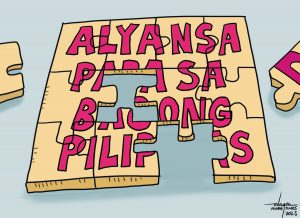As we wrote in our column yesterday, we were in San Isidro and Governor Generoso, Davao Oriental passing by the town of Lupon Thursday and Friday last week.
In that trip we learned two life-changing developments in that part of eastern Davao Province’s western municipalities. We have taken up in our last treatise the fate of San Isidro and Governor Generoso’s subsistence fishermen and the situation of the two towns’ fishing ground. This development is purely negative insofar as the economic condition of the small fishermen’s families is concerned. The latter issue however, could well be both positive and negative depending on which perspective the people in the town concerned take a hard look on.
Yes, we learned that in the Municipality of Lupon, specifically in barangay Sumlod and neighboring areas, there are already several thousand hectares of what were previously purely coconut farms, being leveled to give way to the entry of the banana export giant company Tagum Agricultural Development Corp. (TADECO).
According to certain local officials in San Isidro town, the Municipality of Lupon has not been able to resist temptation from the potential economic benefits accruing the local government from the giant banana farms that will be opened soon in the area. And the coconut farm owners too, seeing their plants growing much older and already slowing down in its fruit bearing capacity, “surrendered” from the glow of the color of big money.
Yes, according to our new friends at the nearby San Isidro, the banana firm is offering farm owners rental of their property at P25,000 per hectare annually with a minimum contract of five years subject to renewal.
According to our informants most coconut farmers own an average of 5 hectares farm land. Thus, when leased, it would earn them instant cash of P125,000 per year. If the company is to advance payment for the first three years upon signing of the lease agreement, then the property owners stand to get P375,000 immediately after the contract signing. Then there is the promise to have the qualified owner’s children get employment in the banana company. Hence, the not-so-serious thinkers among them, for certain, grab the opportunity.
On the part of the local government of Lupon, the enticement could include opportunity for new businesses to open especially those that will engage in the supply of farm chemicals, fertilizers and other inputs, employment, food and beverages, and of course the huge business and license taxes that the agricultural firm will be paying the local coffer. In other words, it is the changed economic landscape that the town administration is looking forward with the opening of the banana farms.
However, we also were informed of the concern of some sectors that the opening of a huge banana plantation in that part of Davao Oriental could also destroy the environment of Lupon and nearby municipalities.
According to our friends from there, there are environmentalist groups who are very much worried of the increased vulnerability of Lupon to floods. What with the cutting of all coconut trees in the plantation area; what with the potential saturation of poisonous pesticides and fertilizers into the aquifers since the new banana plants will have to be supported with every available inorganic farm inputs to ensure its maximum fruiting potentials. And knowing that canals are part of the design of banana farms to ensure the retention of ideal soil moisture, rainwater will all definitely be flowing to the canals and emptying into the nearest river. When this is prevalent in the plantation area then floods will not be far behind.
Well, the effects of all these could be chilling to the people of Lupon and its neighboring towns. But then again, as we love to quote, “The real measure of development is whether the implementation of projects would result to bigger number of people benefiting from it compared to the number of those who stand to suffer from its consequences.”
In other words, the opening of new huge banana farms in that part of the Davao Region is a matter of waiting and seeing the outcome as perceived, as well as the waiting and seeing whether there is truth to the apprehension of some sectors of the town’s population on the project.
So, “Let us to see and to wait,” according to the late Davaoeno Senator Alejandro “Landring” Almendras.
Good luck to the people of Lupon.
-30-


